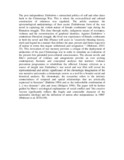Please use this identifier to cite or link to this item:
https://cris.library.msu.ac.zw//handle/11408/1458| Title: | Violence, conflict helix and the reconstruction of gendered identities: a chronotopic imagination In Zimbabwean liberation-war novel and film. | Authors: | Viriri, Advice | Keywords: | Violence, liberation struggle,social conflict. | Issue Date: | 2015 | Publisher: | Africa Institute for Culture, Peace, Dialogue & Tolerance Studies. | Series/Report no.: | Journal of African Security, Peace and Tolerance Studies.; | Abstract: | The post independence Zimbabwe s entrenched politics of self and other dates back to the Chimurenga War. This is where the socio-political and cultural construction of otherness was regulated. The article examines the epistemological underpinnings of then ascent Zimbabwean form of the war novel in capturing the violent nature of female combatants' rape during the liberation struggle. This done through myths, indigenous means of resistance, violence and the reconstruction of gendered identities. Against Zimbabwe 's contentious liberation struggle, the lived war experiences of female combatants in both the novel and film (Flame) will assist in "creatively blending history, myth and legend in a manner that defines the past, present and future trajectory of nation in terms that negate withdrawal and resignation " (Muhwati, 2011: 33). This invocation of war memory provides a critique of the deployment of antinomies of the past Chimurenga war in order to stimulate an evaluation of the present fore grounded post-colonial consciousness. The chosen novels and film’s portrayal of violence and antagonisms provide an over arching contemporary thematic and conceptual analyses that nurtures violence prevention programmes to rehabilitate the affected. Literary criticism as a source of insight into Zimbabwe’s war novel and war film will reveal the representational and artistic significance of the chronologic imagination of the war narrative and exudes a chronotopic oeuvre as a tool for a broader social and historical analysis. By chronotopic, the researcher refers to the intrinsic connectedness of temporal and spatial relationships that are artistically expressed in literature" (Bakhtin 1994) and as the indissoluble combination of [...] two elements": plot and story (Holquist 1994). The paper will be further guided by Marx's sociological explanations of social conflict and "this creative version significantly reflects the fragile and contestable character of the nationalist ideology and the definition of nation after independence in 1980" (Muhwati et al, 2010:149). | URI: | http://hdl.handle.net/11408/1458 | ISSN: | 2307-5155X |
| Appears in Collections: | Research Papers |
Files in This Item:
| File | Description | Size | Format | |
|---|---|---|---|---|
| Violence, conflict.pdf | Abstract | 11.74 kB | Adobe PDF |  View/Open |
Page view(s)
106
checked on Sep 17, 2025
Download(s)
14
checked on Sep 17, 2025
Google ScholarTM
Check
Items in MSUIR are protected by copyright, with all rights reserved, unless otherwise indicated.



